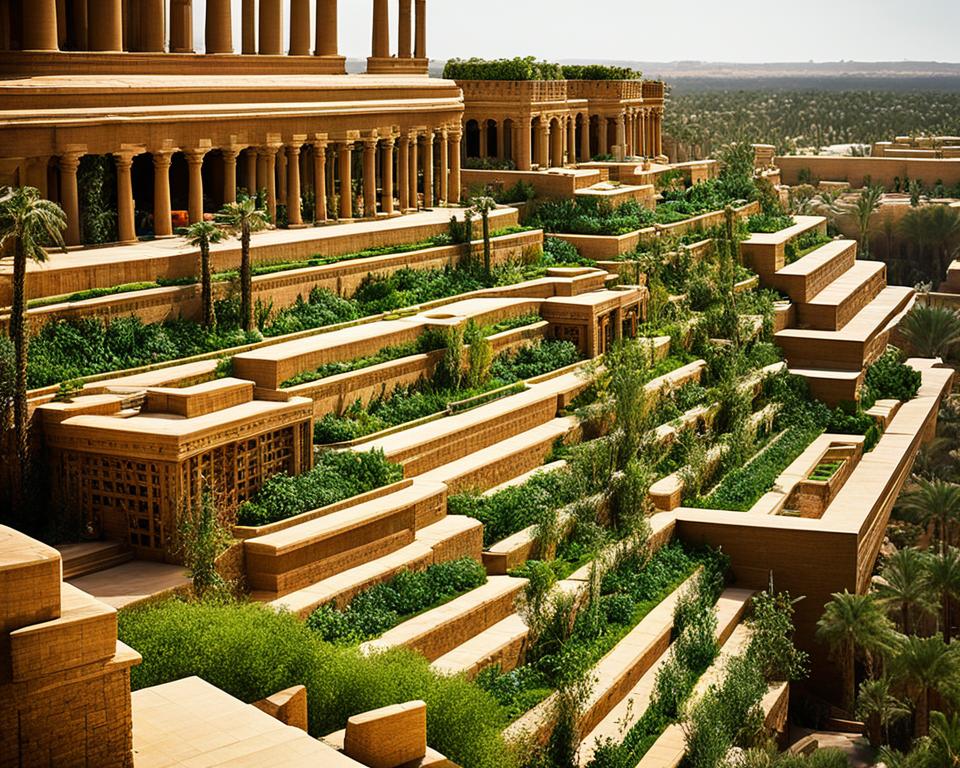Adverts
Discover the wonders of the ancient world and the exciting space exploration! The Seven Wonders of the Ancient World are astonishing feats of human imagination and engineering. They include the Great Pyramid of Giza, O Mausoleum at Halicarnassus, O Temple of Artemis, The Statue of Zeus, O Lighthouse of Alexandria, you Hanging Gardens of Babylon and the Colossus of Rhodes. Although many of these wonders have disappeared over the centuries, we can still marvel at the Great Pyramid of Giza, which remains standing as a witness to ancient Egypt's glorious past.
Adverts
Main points of this article:
- Discover the Seven Wonders of the Ancient World and their fascinating stories.
- A Great Pyramid of Giza It is the only wonder of the ancient world that still exists.
- Meet the incredible ancient egypt architecture and the feats of human engineering.
- A space exploration opens up new possibilities to discover the wonders of the universe.
- Marvel at the unknown and uncover the mysteries of the universe in constant expansion.
The Great Pyramid of Giza
The Great Pyramid of Giza is one of the most iconic monuments in ancient egypt architecture and one of the biggest feats of human engineering. Also known as the Pyramid of Cheops, it is the only Wonder of the Ancient World that still exists virtually intact. Built as the tomb of Pharaoh Cheops, the pyramid is the largest of the three pyramids located on the Giza Plain, on the outskirts of Cairo.
Standing at an impressive 146.5 meters tall, the Great Pyramid of Giza was considered the tallest man-made structure in the world for centuries. Its construction required meticulous work and sophisticated engineering. The pyramid was constructed using approximately 2.3 million stone blocks, each weighing an average of 2.5 tons. The transportation and fitting of these blocks demonstrates the skill and precision of the ancient Egyptians.
Adverts
The construction of the pyramid is believed to have taken about 14 years to complete. The builders used advanced techniques to erect the structure, including internal and external ramps that allowed the stone blocks to be moved to their desired locations. The precision of the construction is remarkable, as the faces of the pyramid are almost perfectly aligned with the cardinal points.
The Great Pyramid of Giza continues to inspire wonder and fascination to this day. It represents the grandeur and splendor of ancient Egyptian civilization and the advanced knowledge that the Egyptians possessed in regard to architecture and engineering. Its preservation over the centuries is a testament to the exceptional work carried out by the ancient Egyptians.
Interesting facts about the Great Pyramid of Giza:
- It is the oldest of the Seven Wonders of the Ancient World, dating back to approximately 2560-2540 BC.
- It is one of the most visited and studied monuments in the world today.
- The height of the pyramid is equivalent to a 40-story building.
- Its interior houses the burial chamber of Pharaoh Cheops.
- It was considered the tallest structure in the world for centuries, until the construction of Lincoln Cathedral in the 14th century.
- Well preserved, the pyramid is an enduring symbol of the grandeur of ancient Egypt.
The Mausoleum at Halicarnassus
O Mausoleum at Halicarnassus It was built by Mausolus, a powerful Persian ruler, as a tomb for himself and his wife Artemisia. Designed by the Greek architects Satyros and Pythius, the mausoleum had three levels and combined different architectural styles. Made of white marble, it was an imposing structure and stood on a hill overlooking the city of Halicarnassus, present-day Bodrum, in Turkey.
| Details | Information |
|---|---|
| Location | Halicarnassus, present-day Bodrum, Türkiye |
| Built by | Mausolus and Greek architects Satyros and Pythius |
| Size | Three levels |
| Materials | White marble |
| Architectural style | Combination of different styles |
The Statue of Zeus
A Statue of Zeus, one of the Seven Wonders of the Ancient World, was a magnificent tribute to the supreme god of the ancient Greeks. Created by the renowned sculptor Phidias, this greek sculpture impressive was located in the Temple of Zeus at Olympia.
A Phidias' sagacity is revealed in this masterpiece of sculpture, which depicted Zeus seated on a throne. The god held a statue of the goddess of victory, Nike, in one hand, while the other held a scepter with an eagle. The statue was made of ivory and gold, inlaid with precious stones, giving it a majestic and imposing appearance.
See too:
For over eight centuries, this magnificent sculpture has attracted travelers from all over the world to Olympia, admiring its beauty and grandeur. Unfortunately, the statue was destroyed in a fire during the Late Antiquity period and no trace of it remains today.
The Hanging Gardens of Babylon
You Hanging Gardens of Babylon are one of the most mysterious wonders of the ancient world. Although there are detailed descriptions in ancient texts, there is no conclusive evidence that they actually existed.
According to descriptions, the gardens were an engineering marvel, maintaining a lush, living garden in the desert. They are believed to have been the creation of King Nebuchadnezzar II, but there are theories that their existence may have been a legend.

Despite the uncertainties, the image popularly associated with Hanging Gardens of Babylon is a representation of beauty and grandeur. Its possible format in incredibly decorated terraces, full of plants and trees, showed a harmony between nature and the design of ancient engineering.
While the actual existence of the gardens remains a mystery, their presence in Babylonian history and culture is undeniable. The legend of the Hanging Gardens of Babylon continues to intrigue curious minds and inspire tales and artistic depictions throughout the centuries.
The Lighthouse of Alexandria
O Lighthouse of Alexandria It was built on the coast of Egypt to serve as a light tower in the port of Alexandria. At nearly 140 meters tall, it was the second largest man-made structure in the ancient world. The lighthouse was subject to earthquakes over the years, which led to its destruction. However, stones believed to have been part of the lighthouse have been discovered in the waters around Pharos Island.
Data Spotlight
| Name | Location | Height | Year of Construction | Year of Destruction |
|---|---|---|---|---|
| Lighthouse of Alexandria | Port of Alexandria, Egypt | Almost 140 meters | 280 BC | Gradual destruction by earthquakes |
The Temple of Artemis
O Temple of Artemis It was one of the most beautiful sanctuaries in the ancient world. Built in marble, it was dedicated to Artemis, the goddess of hunting and childbirth. The temple was an impressive 91 meters long and 45 meters wide.
However, the temple was destroyed by flood, arson, and invasion over the centuries. Few ruins of the temple can still be found in Ephesus, Turkey.
Conclusion
The exploration of the universe has revealed many unknown mysteries and wonders. With advances in technology and science, scientists have made incredible discoveries about distant planets, stars, and galaxies. These discoveries show us the grandeur and complexity of the universe we live in.
However, there is still much to be unraveled and understood. mysteries of the universe are challenging and fascinating, sparking our curiosity about the origin of the universe, the existence of extraterrestrial life, and the fundamental principles of physics and cosmology. space exploration is the means by which we continue to unravel these unknowns.
As we expand our space exploration efforts, we can expect more scientific discoveries surprising. Each space mission brings us closer to answers that previously seemed unattainable. Through space exploration, we are increasing our knowledge and pushing the boundaries of our understanding of the universe. These discoveries are fundamental to our scientific and technological evolution.
You mysteries of the universe will never cease to fascinate us. As we continue to explore space, we are getting closer and closer to the answers we seek. Each new scientific discovery brings us closer to understanding our existence and our place in the vast cosmos. Space exploration remains one of humanity’s greatest adventures, taking us beyond Earth’s borders and opening doors to an exciting future of knowledge and new discoveries.
FAQ
What are the Seven Wonders of the Ancient World?
The Seven Wonders of the Ancient World are astonishing feats of human imagination and engineering that include the Great Pyramid of Giza, the Mausoleum at Halicarnassus, O Temple of Artemis, The Statue of Zeus, the Lighthouse of Alexandria, the Hanging Gardens of Babylon and the Colossus of Rhodes.
How many of the Seven Wonders of the Ancient World still exist today?
The Great Pyramid of Giza is the only Wonder of the Ancient World that still exists virtually intact.
What are the dimensions of the Great Pyramid of Giza?
The Great Pyramid of Giza is 146.5 meters high and is the largest of the three pyramids at Giza.
Who built the Mausoleum at Halicarnassus?
The Mausoleum at Halicarnassus was built by Mausolus, a powerful Persian ruler, as a tomb for himself and his wife Artemisia.
Who was the sculptor responsible for creating the Statue of Zeus?
The Statue of Zeus was created by the sculptor Phidias.
Where are the ruins of the Temple of Artemis located?
Few ruins of the Temple of Artemis can still be found in Ephesus, Turkey.
What has space exploration revealed about the universe?
With advancements in technology and science, space exploration has revealed many unknown mysteries and wonders, including distant planets, stars and galaxies.




